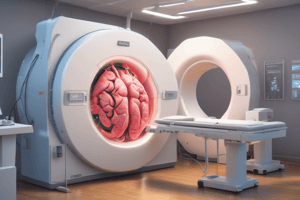Podcast
Questions and Answers
What is the main purpose of high-resolution CT (HRCT) imaging of the lungs?
What is the main purpose of high-resolution CT (HRCT) imaging of the lungs?
In the provided CT image (C), what does the black arrow indicate?
In the provided CT image (C), what does the black arrow indicate?
Which of the following conditions can cause bronchial casts or plugs?
Which of the following conditions can cause bronchial casts or plugs?
What is the most common location for a foreign body aspiration in children?
What is the most common location for a foreign body aspiration in children?
Signup and view all the answers
Which imaging modality is recommended for assessing pleural effusion?
Which imaging modality is recommended for assessing pleural effusion?
Signup and view all the answers
According to the provided information, which of the following conditions can lead to retained secretions in the airways?
According to the provided information, which of the following conditions can lead to retained secretions in the airways?
Signup and view all the answers
Which of the following is NOT a common method used to investigate respiratory disease?
Which of the following is NOT a common method used to investigate respiratory disease?
Signup and view all the answers
What is the typical direction of lung collapse in a pneumothorax?
What is the typical direction of lung collapse in a pneumothorax?
Signup and view all the answers
Which of the following is the LEAST common cause of lung collapse?
Which of the following is the LEAST common cause of lung collapse?
Signup and view all the answers
Which of the following imaging modalities is LEAST useful for evaluating thoracic trauma?
Which of the following imaging modalities is LEAST useful for evaluating thoracic trauma?
Signup and view all the answers
Which of the following lung lobes is LEAST likely to collapse in a pneumothorax?
Which of the following lung lobes is LEAST likely to collapse in a pneumothorax?
Signup and view all the answers
Which of the following is the MOST sensitive test for detecting a pneumothorax?
Which of the following is the MOST sensitive test for detecting a pneumothorax?
Signup and view all the answers
Which of the following is the LEAST common radiological sign of a tension pneumothorax?
Which of the following is the LEAST common radiological sign of a tension pneumothorax?
Signup and view all the answers
Which of the following imaging modalities is LEAST useful for evaluating a suspected diaphragmatic injury?
Which of the following imaging modalities is LEAST useful for evaluating a suspected diaphragmatic injury?
Signup and view all the answers
Which of the following is the LEAST common radiological sign of a traumatic lung contusion?
Which of the following is the LEAST common radiological sign of a traumatic lung contusion?
Signup and view all the answers
Which of the following imaging modalities is LEAST useful for evaluating a suspected esophageal rupture?
Which of the following imaging modalities is LEAST useful for evaluating a suspected esophageal rupture?
Signup and view all the answers
What is the main cause of all hypoxia problems at high altitudes?
What is the main cause of all hypoxia problems at high altitudes?
Signup and view all the answers
Which of the following is a characteristic direction of lung lobe collapse?
Which of the following is a characteristic direction of lung lobe collapse?
Signup and view all the answers
What is the purpose of an anteroposterior (AP) chest X-ray?
What is the purpose of an anteroposterior (AP) chest X-ray?
Signup and view all the answers
What is the characteristic appearance of the right upper lobe collapse on a chest X-ray?
What is the characteristic appearance of the right upper lobe collapse on a chest X-ray?
Signup and view all the answers
What is the effect of chronic mountain sickness on the cardiovascular system?
What is the effect of chronic mountain sickness on the cardiovascular system?
Signup and view all the answers
Which of the following is a common cause of lung collapse?
Which of the following is a common cause of lung collapse?
Signup and view all the answers
What is the purpose of a postero-anterior (PA) chest X-ray?
What is the purpose of a postero-anterior (PA) chest X-ray?
Signup and view all the answers
What is the characteristic direction of collapse for the left upper lobe?
What is the characteristic direction of collapse for the left upper lobe?
Signup and view all the answers
What is the primary mechanism of acute pulmonary edema at high altitudes?
What is the primary mechanism of acute pulmonary edema at high altitudes?
Signup and view all the answers
How does the acclimatized person respond to high-altitude hypoxia compared to the unacclimatized person?
How does the acclimatized person respond to high-altitude hypoxia compared to the unacclimatized person?
Signup and view all the answers




